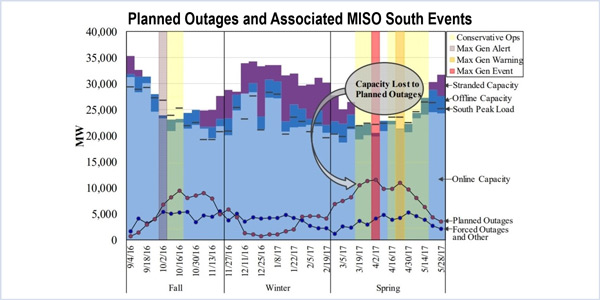By Amanda Durish Cook
MISO’s Independent Market Monitor still sees room for significant improvement after giving the RTO’s markets a passing grade for last year.
“Although the energy markets generally set efficient prices in 2016, we recommend improvements to MISO’s price formation through improved shortage pricing and price-setting by peaking resources,” Monitor David Patton said in his annual State of the Market report released last week, which included nine new recommendations.
The Monitor concluded that — based on the “output gap” measure of economic withholding (the difference between potential and actual energy output) — “potential” withholding of generation represented just 0.11% of load and scarcity mitigation was “infrequently implied.”
The report also showed that modest declines in fuel prices contributed to slightly lower energy prices, make-whole payments and congestion costs than in 2015. MISO’s peak load of 121 GW was slightly higher than the previous year but well below the forecasted peak of 125.9 GW because of mild weather and lower loads. Real-time congestion, however, rose 4.3% from 2015, totaling about $1.4 billion, “amongst the highest in the U.S.,” according to Patton, which he in part attributed to high outage rates in MISO South.
The Monitor’s new market recommendations — many of them already familiar to MISO staff and stakeholders — join a rolling list of unimplemented recommendations dating back to 2010:
- Improve shortage pricing by adopting an improved contingency reserve demand curve that reflects the expected value of lost load (VoLL). Patton recommended earlier this year that the RTO immediately up its $3,500/MWh VoLL limit to $9,000/MWh and change its operating reserve demand curve calculation to a sloped curve that he contends would better price shortages. (See MISO, IMM Differ over Scarcity Pricing Changes.)
- Transfer control of market-to-market flowgates to improve procedures for M2M activation and coordination. The Monitor would like to see MISO, PJM and SPP become more active in transferring monitoring of constraints when the non-monitoring RTO has all of the transmission loading relief on a flowgate. Last month, MISO and SPP announced plans to begin swapping flowgate control. (See MISO Interregional Plans with SPP Echo PJM Efforts.)
- File changes with FERC to give MISO increased authority to approve generation and transmission planned outages and the ability to coordinate outage schedules in order to lower costs. The Monitor said the move would reduce both outage-related congestion during peak outage season and capacity-related emergency events during the shoulder months. Currently, the RTO can only recommend outage schedules and work with operators to reschedule planned outages when reliability is at risk. Last month, both MISO and the Monitor expressed concern over higher-than-usual planned outages in MISO South during the spring. (See MISO South Outages Worry RTO, Monitor.) The Monitor reported that from January 2016 to May 2017, 25% of all real-time congestion ($457 million) could be traced to concurrent generation outages.
- Establish regional reserve requirements, creating a local, 30-minute reserve product and developing procurement requirements in areas with voltage and local reliability needs. The Monitor said the reserve product will align the market with reliability needs, allow MISO to accurately price subregional shortages and “lower costs by allowing the markets to satisfy MISO’s reliability needs and reducing out-of-market actions by MISO operators.” Like several other 2016 State of the Market recommendations, this recommendation appeared earlier this year when the Monitor submitted it for consideration in the RTO’s Market Roadmap list of market changes. (See MISO Steering Committee OKs IMM Proposals for Market Roadmap.)
- Change MISO’s Day-Ahead Margin Assistance Payment (DAMAP) and Real-Time Offer Revenue Sufficiency Guarantee Payment (RTORSGP) rules to compensate wind operators whose output more closely matches their day-ahead forecasts and reduce gaming opportunities and unjustified costs. Patton warned the RTO late last year that wind generators appeared to be deliberately over-forecasting their output to inflate payments made through revenue sufficiency guarantees. (See MISO IMM Sees Deliberate Over-Forecasting by Wind Operators.)
- Increase the accuracy of MISO’s Look-Ahead Commitment recommendation, which was developed in 2012, and seek to improve resource commitment by modeling system conditions for a three-hour future time frame.
- Improve forecasting incentives for wind resources by creating a method to validate wind supplier forecasts and use the results to alter dispatch instructions if needed, while improving forecasting incentives by modifying deviation thresholds and settlement rules.
- Disqualify from the Planning Resource Auction any resources expected to be unavailable during peak conditions. MISO is currently shopping its own proposal to prohibit resources on extended outages from participating in future auctions or making changes to capture the risk of such outages in loss-of-load-expectation analyses. (See MISO May Bar Units on Extended Outage from Capacity Auctions.)
The Monitor also warned that the $1.50/MW-day footprint-wide clearing price in MISO’s spring capacity auction was too low to be sustainable.
“This is essentially zero. This is not an efficient price under current capacity levels and will motivate poor retirement and export decisions by MISO’s competitive suppliers,” Patton said.
Despite FERC’s rejection of a three-year forward market design for MISO’s retail-choice areas, the RTO should pursue “more reasonable and efficient alternatives,” he added.





